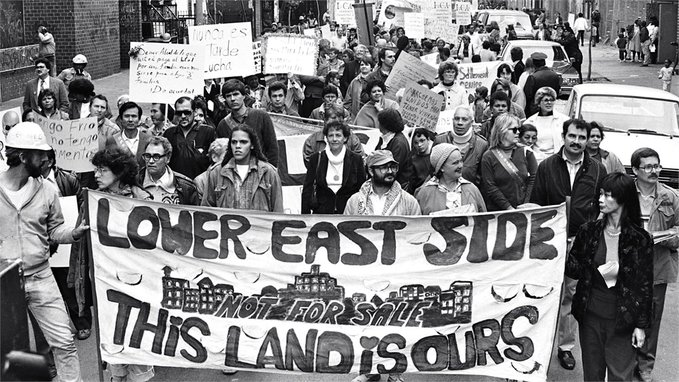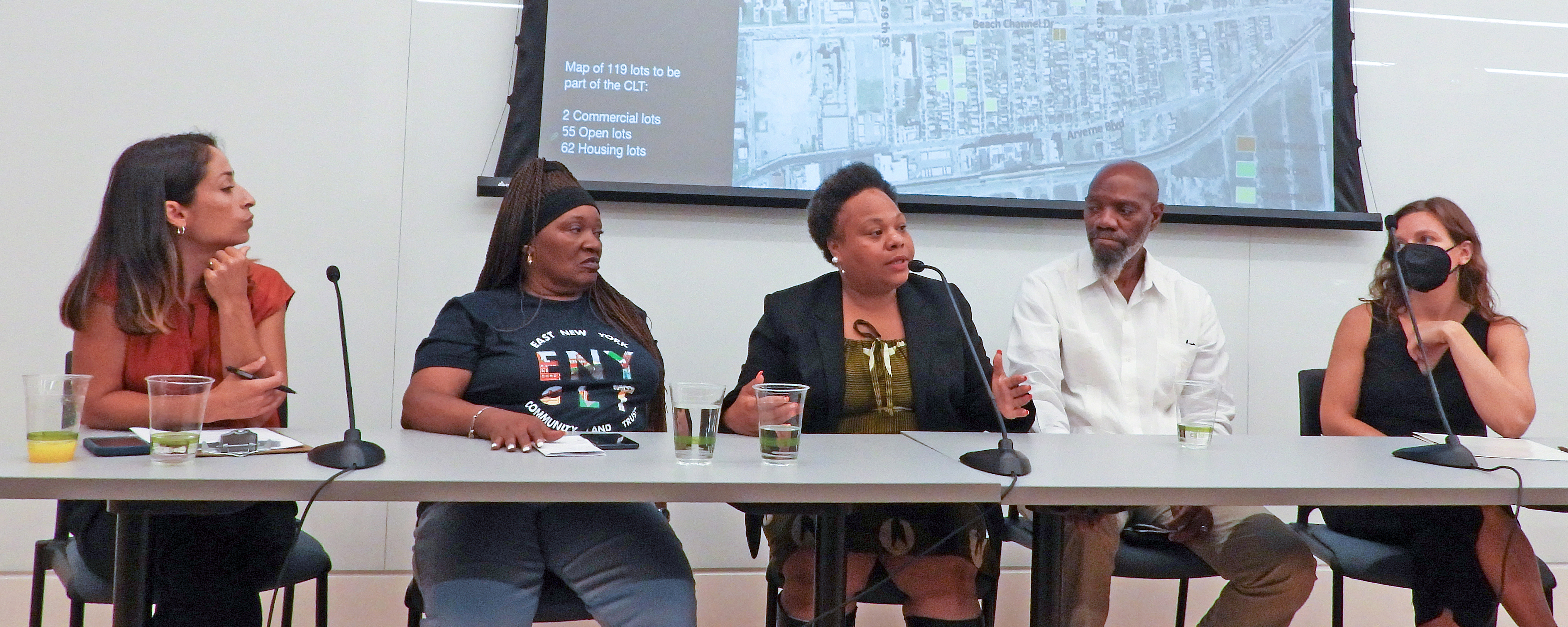Blog
September
2023
22
From Grassroots Organizing to Land Victories: New York’s Community Land Trust Movement Surges Forward
This month, New Economy Project co-sponsored two inspiring events that highlighted the community land trust (CLT) movement’s tremendous recent progress – and the urgent public policies needed to further bolster democratic control of land in New York City.
CLTs are community-controlled nonprofit organizations that take land and housing off the speculative market and steward that land for the public good. Skyrocketing rents, housing and cultural displacement of Black and brown New Yorkers, and the continuing housing and homelessness crisis have fueled CLT organizing in low-income neighborhoods throughout the city. Today, more than 20 CLTs are in various stages of development across the five boroughs.
The two convenings – a film screening and panel about the city’s longest-running CLT, and an event highlighting the movement’s latest victories – illuminated the crucial role that CLTs play in furthering racial justice, community equity, and true participatory planning. They also made evident that ongoing, inclusive, and tenacious organizing is vital for CLTs to achieve their transformational goals and contribute to long-term systemic change.
Rabble Rousers screening: CLTs no longer a “unicorn” housing model

On Friday, Sept. 8, the Urban Democracy Lab at NYU hosted a screening of Rabble Rousers: Frances Goldin and the Fight for Cooper Square. The film documents how a diverse group of grassroots organizers and tenants on the Lower East Side, led by resident Francis Goldin, stood up to city planning czar Robert Moses, rejecting his 1959 slum clearance plan for the neighborhood that would have displaced 2,400 working class and immigrant families.
Rather than simply saying no to urban renewal, residents proposed their own block-by-block plan – developed democratically through countless meetings – that would benefit existing residents as well as protect them from displacement. Their struggle over five decades, from the 1950s through the 1990s, culminated in the formation of the city’s first community land trust: Cooper Square CLT. To this day, the CLT owns and stewards the land under 23 buildings providing deeply and permanently affordable housing for 910 Lower East Side residents.
One might imagine that in an era where vacant real estate was both cheaper and more ubiquitous than it is today, Cooper Square’s activists had a relatively easy time forming a CLT. But Rabble Rousers reveals the extent to which they faced obstacles of every sort, including Moses’ ire, schemes between policymakers and developers, dead silence from city government, federal and city disinvestment, drugs, arson, and later, gentrification. In their battle for community control, organizers attended – and were arrested at – city hearings, glued shut the doors of a city office building, and dumped Cooper Square’s garbage in front of City Hall, among other direct actions.
The film also acknowledges the limitations of Cooper Square’s victory, in the absence of broader systemic change: the CLT is a pocket of affordability in a heavily gentrified Lower East Side. Yet the CLT’s success would also spur future generations of housing organizers to fight for community control: the film ends with footage of East Harlem/El Barrio CLT, the first in a new wave of NYC-based CLTs to form in the 21st century.
At a panel following the screening, speakers reflected on Cooper Square’s impact and legacy.
Dave Powell, executive director of the Cooper Square Mutual Housing Association (and one of the filmmakers behind Rabble Rousers), credited Picture the Homeless for reawakening interest in the CLT model in the 21st century. Drawing inspiration from Cooper Square and other CLTs focused on deep housing affordability, Picture the Homeless co-founded the New York City Community Land Initiative (NYCCLI), a citywide alliance that has fostered the growth of CLTs across the city over the past decade. Thanks to this ongoing work, Cooper Square is no longer seen as a “unicorn model” but as the launchpad for a growing movement for land and housing justice.
Will Spisak of New Economy Project, which co-founded and coordinates NYCCLI, emphasized the need to “preserve CLTs’ radical origins and their focus on racial justice” as the movement grows in New York City. Will noted that the first CLT in the United States, New Communities, was spearheaded by Black civil rights activists and farmers in Georgia during the 1960s.“We need to continue to emphasize the origins of the CLT, its importance as a process of decommodifying land, and the vital role of stewardship and democratic governance.”
Amir Bey, an artist, longtime resident, building captain, and former board member of Cooper Square Mutual Housing Association, stressed that CLT organizers and leaders are “motivated by a very personal feeling of love for home and family. That’s what makes a CLT effective,” he said. “The sincere motivation of the people who are using it or employing it.” Cultivating that sense of community is central to sustaining a CLT’s mission over time.
“Gaining Ground” panel: victories across the boroughs

The following Tuesday, Sept. 12, nearly 300 organizers, policymakers, academics and funders gathered – in person and virtually – for “Gaining Ground: What’s Next for NYC’s Community Land Trusts,” a panel discussion on the CLT movement’s latest wins and next steps. Co-sponsored by New Economy Project, the Pratt Center for Community Development, and NYCCLI, the panel built on the research and recommendations of Pratt’s recent report documenting CLTs’ emergence as a powerful tool to address the city’s affordability crisis and racialized displacement.
New Economy Project’s co-director Deyanira Del Rio kicked off the event by highlighting the progress made since NYCCLI’s formation a decade ago, when few local groups and policymakers understood the CLT model, notwithstanding Cooper Square CLT’s success. “The coalition spent much of its early years developing popular education tools, conducting hundreds of community workshops and presentations – really just helping people understand what a CLT is, how it could benefit communities and help address root causes of our housing and greater affordability crisis,” she said.
A two-year CLT learning exchange, coordinated by New Economy Project and NYCCLI from 2017-2019, further bolstered interest and hands-on learning for a dozen groups working to establish CLTs. Today, NYC is home to more than 20 CLTs – one-third of which own or are in active stages of acquiring land for deeply and permanently affordable housing and other community needs.
Deyanira also noted growing policy support for CLTs, generated by NYCCLI’s collective organizing and advocacy. A near-supermajority of Council Members has sponsored key bills in the Community Land Act, a legislative package to help CLTs bring more land and housing into community ownership; and the Council has awarded $6 million for CLT organizing and technical support since 2020. At the state level, NYCCLI has joined forces with Housing Justice for All and others to win legislation and funding for CLTs and other forms of social housing, as a next stage in the fight for housing justice.
Organizers from CLTs across three boroughs described how they became involved in the movement while highlighting exciting recent successes.
Mychal Johnson of the Mott Haven-Port Morris Community Land Stewards announced that after a decade-long campaign in the South Bronx, the CLT has received the city’s greenlight to redevelop an abandoned city-owned building into a Health, Education and Arts (HEArts) Center, bringing urgently-needed services to the community.
The abandoned building has a unique history as the “Lincoln Detox Center,” a holistic drug treatment center founded by the Young Lords and the Black Panthers in the 1970s. For years, CLT organizers worked with local residents to envision how the vacant building could be used to benefit the community. After working with architects and other experts to create a feasibility study, the community successfully pressed the city to release a Request for Proposals (RFP) – which the CLT subsequently won – for the building’s redevelopment.
“It’s important that we’re not recreating the same mechanisms that have caused the harm: top-down decisions,” Mychal told the audience. “It has to be ground-up. It has to be community-driven.”
East New York CLT co-founder Debra Ack announced that the CLT is on track to acquire its first land parcel this November. The CLT is working with tenants of a 21-unit building on Arlington Avenue to buy the building from their willing landlord. East New York CLT is more than halfway to its $1 million fundraising campaign to purchase the building, which it plans to convert to tenant-ownership while the CLT retains ownership of the land.
Debra, who recently received the Just Brooklyn Prize in recognition of her work with the East New York CLT, noted the CLT’s focus on spreading the word and educating the community about this underutilized model.
“Being part of the East New York CLT has really changed my mindset about how things should be done in our community,” she said. “Yes, the land is ours–we need to take back our land, and give it back to the people of the community, and…let them decide, as a community, what is to be built on these vacant lots.”
ReAL Edgemere CLT founder and board chair Alexis Foote shared how the CLT is poised to take over 119 city-owned lots in the Rockaways. The CLT envisions developing affordable housing along with park space and other resiliency infrastructure near the waterfront to protect the community from future flooding. Ultimately, Foote says, CLTs are really a fight for racial justice and reparations.
“When I took on this challenge, that’s what it was really about for me: ending generational homelessness,” she said, explaining that she and her mother had suffered homelessness, and that she aims to ensure her children and others never have that experience.
Sylvia Morse of the Pratt Center underscored that, despite strong progress, CLTs still need significantly more financial investment. She noted that the City’s Department of Housing Preservation and Development is already understaffed, and expressed concerns that Mayor Eric Adams’ recently announced budget cuts will further impair the city’s ability to support equitable and community-led development.
“The reality is that from the federal government down to the city, we’ve seen for decades disinvestment in low income housing, capital and operations,” said Sylvia. “Community land trusts will be subject to the same challenges of all forms of affordable housing if we do not invest subsidies in making sure that housing can reach the lowest income tenants. That is something that we’ll have to continue to fight for, for community land trusts and for all forms of affordable housing.”
Take Action to Support the Growing Community Land Trust Movement!
- Urge your City Council Member to pass the Community Land Act using this tool and have your organization endorse the campaign! Learn more at nyccli.org/CLA.
- Get involved or request a workshop by contacting Elise Goldin, CLT Campaign Organizer at New Economy Project: elise@neweconomynyc.org.